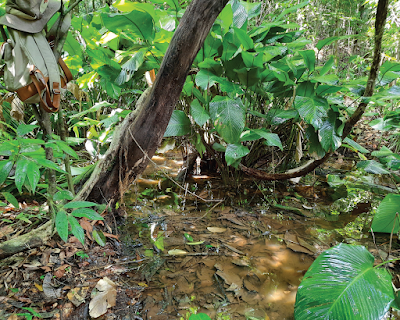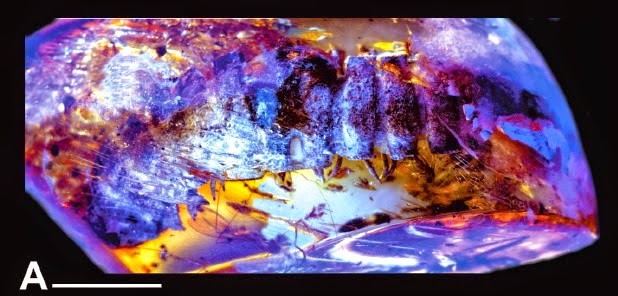Salamanders of the genus Tylototriton, known as Crocodile Newts for the scale-like knobbly protuberances on their skin, are found across the Himalayan Region, Southeast Asia, and South and Central China. There are currently 40 described species, most of which are highly endemic (have very limited distributions), with several known undescribed species in Southeast Asia. There are currently six described species from Thailand, Tylototriton verrucosus, Tylototriton uyenoi, Tylototriton anguliceps, Tylototriton phukhaensis, Tylototriton umphangensis, and Tylototriton panhai, five of which have been described since 2013.
In a paper published in the journal ZooKeys on 15 October 2024, Porrawee Pomchote of the Department of Biology at Chulalongkorn University, Parada Peerachidacho of the Research Institute for Languages and Cultures of Asia at Mahidol University, Wichase Khonsue also of the Department of Biology at Chulalongkorn University, Pitak Sapewisut of the Department of Biology at Chiang Mai University, Axel Hernandez of the College of Biology & the Environment at Nanjing Forestry University and the Department of Environmental Sciences at the University Pasquale Paoli of Corsica, Chitchol Phalaraksh, also of the Department of Biology at Chiang Mai University, Parunchai Siriput of the Department of National Parks, Wildlife and Plant Conservation, and Kanto Nishikawa of the Graduate School of Global Environmental Studies and Graduate School of Human and Environmental Studies at Kyoto University, describe a new species of Crocodile Newt from Mae Tuen Wildlife Sanctuary in Tak Province, northwestern Thailand.
In July 2014, Axel Hernandez discovered a male Crocodile Newt in a muddy pond in the middle of a Dipterocarp and mixed deciduous forest close to the top of Doi Soi Malai (Mount Soi Malai), about 1500 m above sealevel. He initially assigned this to Tylototriton uyenoi, a species which had been described the previous year from the same area. However, subsequent examination of the specimen showed that it differed from Tylototriton uyenoi in a number of ways. In 2015 the Tourism Authority of Thailand published a video clip on the MGR Online platform showing Crocodile Newts at the same location. This led to a field study of the area in August 2022, during which three adult male Crocodile Newts and two tadpoles were discovered in a muddy puddle in a road on Doi Soi Malai, again at about 1500 m above sealevel.
Pomchote et al. carried out both genetic and morphological analysis of the Doi Soi Malai specimens, both of which led them to conclude that they were representatives of a new species. This is named Tylototriton soimalai, in reference to the location where it was discovered, Doi Soi Malai.
The known specimens of Tylototriton soimalai are medium-sized Crocodile Newts, ranging from 90.7 mm to 109.3 mm in length, with and are black in colour (dark grey on the underside), with two orange ridges on either side of the dorsal surface of the skull, behind which are two rows of orange nodules which follow the length of the body, but not the tail, while a third, solid orange ridge follows the length of the spine, including the tail.
The two tadpoles vary in size, with one roughly double the size of the other, despite being found at the same time. In both, the head is large with visible eyes, and three pairs of reddish-brown external gills. The tadpoles are pale brown in colour with scattered black markings, and purple-silver markings around the eyes and fin, and on the flanks.
All of the specimens were found in a muddy puddle roughly 10 m long and 5 m wide, with a maximum depth of about 35 cm. They were found at about midday on 31 August 2022, which is in the rainy season; this is presumed to be the breeding season of the Newts. The puddle is located on a road running over Doi Soi Malai, with the exact location not given to protect the species from illegal collection.
Pomchote et al. note that the road is extensively used by mountain bike and four-wheel-drive enthusiasts, particularly during the monsoon season, despite these activities being banned in national parks and wildlife sanctuaries in Thailand by the Department of National Parks, Wildlife and Plant Conservation. For this reason, Pomchote et al. recommend that the road should be closed off completely during the monsoon season, remaining open to hikers during the dry and winter seasons. They also note that the environment both within and around the Mae Tuen Wildlife Sanctuary has been degraded by deforestation and fragmentation for agricultural use, primarily cabbage farming. They therefore recommend that Tylototriton soimalai be listed as Endangered under the terms of the International Union for the Conservation of Nature's Red List of Threatened Species.
See also...










%20(1)%20(1).png)












